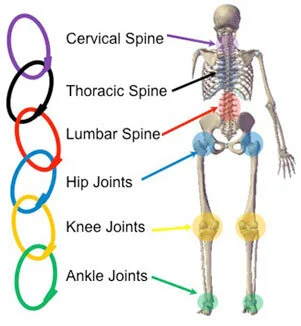Unique Benefit 1-Enhancing the Kinetic Chain
The human body is not a random assortment of isolated parts, but rather a wonderful interconnection of several subsystems. We were not put together like Frankenstein’s monster and for the most part should not train athletes this way. The human body is a series of linked systems that can be referred to as the kinetic chain, and the beauty of calisthenics is it offers the opportunity to improve the connections between the segments. The human flag, as an example, involves a bottom arm pushing action, a top arm pulling action and requires an athlete to connect the hips to the shoulders, through the midsection (core).
#block-5c42d5063ebab6ddb13d {
}
You cannot Humpty Dumpty your way to a human flag by performing lat pull-downs, machine shoulder press and ab machine crunches, the same way you cannot create an athlete by restricting them to machines or barbells. Although barbells and machines have their place, all sporting actions are based on how efficiently your body’s various pieces interact, and for athletic success, you must be greater than the sum of your parts. Callisthenics allows the integration of the body’s subsections to be trained as an integrated unit.
Unique Benefit Number 2 – Closed Chain Movements
Movements can be classified as either open chain or closed chain. In open chain movements, such as the bench press, the torso is fixed and the arms move. In closed chain movements, the hands stay fixed to a surface (i.e. the floor), and the torso moves. The reason this is important is that closed chain movements offer potentially unique benefits to the upper body that we may miss out on if we solely train with barbells including:
-
Improved joint congruency – how well joints interact with each other
-
Enhanced proprioception – how well your body can sense where it is
-
Increased neuromuscular control – your body’s ability to utilise the most effective muscles for the task
-
Greater dynamic joint stability
(Kibler 2000)
The muscles working around a joint to create dynamic stability work much harder in closed chain movements. For evidence of this, have your athletes attempt a frog stand…and then get them to take 1 knee off of their supporting arm and laugh as they likely nearly face plant the floor. Although barbell work absolutely has its place for youth athletes, progressive callisthenics that focuses on intensity (i.e. pushing hard against the ground for 5-10 seconds) will likely do more for both body awareness and dynamic joint stability compared to solely using external resistance.
Unique Benefit 3-Play Time:
A few years ago I visited an S&C coach in a school, and he explained “the primary driver of adaptation in youth athletes is volume …but in order to get that volume kids need to turn up on a consistent basis.” This is where callisthenics has a huge role to play. Sometimes sets, reps and filling out a paper format of a program can seem too much like school work for athletes of a certain maturity level. Ironically, it’s all too easy to forget that youth athletes are actually children.
You may need 3 sets of 10 goblet squat and improving their vertical jump is appealing to them…whereas they may think 3 laps of a ninja warrior-esque obstacle course or having to hang on for dear life to avoid the crocodile is much more appealing. Calisthenics lends itself much more easily to what I call ‘Play with a Purpose’, and programs such as Simon Brundish’s Strength Lab Superheros, have done an awesome job of combining bodyweight movements, kid’s wild imaginations and sensible progressions of fundamental movements.
Unique Benefit 4-Applying Force in Different Ways
It is not so much the achievement of a given movements within calisthenics that are important…but the physical qualities a movement represents. Put another way, it is not about becoming overly focused on passing the calisthenics test, it is about the processes that are involved in doing so. When I first achieved a human flag, my partner’s brother tongue in cheek response was “when are the hanging horizontally for 5 second championships?”
A lot of people mistakenly assume sport specificity = transfer of training
Put another way…most people mistakenly assume that if something looks like the sport in a strength and conditioning program then it must positively improve a person’s ability in said sport. The human flag looks nothing like anything in the sporting world, but it isn’t about preparing you to hang horizontally for 5 seconds.
Instead, it is the culmination of:
-
Strength to bodyweight ratio
-
Pulling strength
-
Pushing strength
-
The ability to connect the lateral sling system (i.e. connecting the arms and the hips through the lateral core)
Majority of S&C coaches will likely include some form of pushing movements, some form of pulling movements and some form of anti-rotation/anti-lateral flexion (see here). Whilst I am not saying the human flag and its regressions can be used in place of all other pulling, pushing…what I am saying is that callisthenics movements broaden the youth athlete’s toolbox in ways that might be inadvertently neglected if all we had them do was use barbells and dumbbells. Callisthenics provides unique opportunities to develop movement qualities and strength outside of sagittal plane (i.e. beyond just up and down movements). Whilst athletes will always be strongest in up and down movements (e.g. squats, deadlifts, pressing variations), the reality of sport means athletes need to be able to express movement, strength and power in up and down movements, side to side movements and rotational movements.
Not only does callisthenics allow athletes to improve movement in all 3 planes of motion, it allows athletes to link movement patterns, and flow in ways that might not be feasible with barbell and dumbbells.
Key Take Homes:
-
Calisthenics provides a unique opportunity to develop strength, mobility and control beyond just up and down movements (i.e. the sagittal plane)
-
So long as you understand the principles of strength training, callisthenics provides a training modality that can be accessed anywhere, at any time, with the added bonus of improving dynamic joint stability and body awareness
-
Callisthenics allows us to develop movement skills that traditional gym-based sets x reps program might not (think parkour, obstacle courses and superheroes)
Key Resources:
School of Calisthenics Virtual Classroom https://classroom.schoolofcalisthenics.com/start
The Mindful Mover http://mindfulmover.com/
Gold Medal Bodies https://gmb.io/
Naked Warrior by Pavel Tsatsouline
School of Calisthenics 2018 UKSCA Presentation Bombproof Shoulders https://www.youtube.com/watch?v=mHCercv2XJs&t=3196s
Simon Brundish’s Strength: Lab Superheros https://strengthlab.co.uk/
References:
Kibler, W.B., 2000. Closed kinetic chain rehabilitation for sports injuries. Physical Medicine and Rehabilitation Clinics, 11(2), pp.369-384.
#block-yui_3_17_2_1_1571844932794_5843 {
}


